Performance of Reinforced Concrete Slab with Opening Strengthened Using CFRP
Abstract
1. Introduction
2. Methodology
2.1. Experimental Setup
2.2. Testing of Slabs
3. Results
3.1. Load, P (kN) vs. Deflection, δ (mm)
3.2. Load, P (kN); Flexural Strength, R (MPa); and Deflection, δ (mm)
- f = Flexural strength
- P = Maximum Load
- a = Distance between Supporting and Loading Pins
- b = Specimen Width
- d = Specimen Thickness
3.3. Stress Concentration Factor, k
4. Discussion
4.1. General
4.2. Cracking and Yield Lines
4.3. Load Carrying Capacity and Deflection
4.4. CFRP and Failure Characteristics
5. Conclusions
Author Contributions
Funding
Acknowledgments
Conflicts of Interest
References
- Mansur, M.A.; Huang, L.M.; Tan, K.H.; Lee, S.L. Deflections of reinforced concrete beams with web openings. ACI Struct. J. 1992, 89, 391–397. [Google Scholar]
- Anwar, A.; Mohammed, B.S.; Liew, M.S.; Wahab, M.A. Below-Grade Sulfur Storage Pits in Oil Refineries: A Review. J. Fail. Anal. Prev. 2019, 1–16. [Google Scholar] [CrossRef]
- Benitez, M.A.; Darwin, D.; Donahey, R.C. Deflections of composite beams with web openings. J. Struct. Eng. 1998, 124, 1139–1147. [Google Scholar] [CrossRef][Green Version]
- Batti, M.; Silva, B.; Piccinini, Â.; Godinho, D.; Antunes, E.G.P. Experimental Analysis of the Strengthening of Reinforced Concrete Beams in Shear Using Steel Plates. Infrastructures 2018, 3, 52. [Google Scholar] [CrossRef]
- Mansur, M.A.; Tan, K.-H. Concrete Beams with Openings: Analysis and Design; CRC Press LLC: Boca Raton, FL, USA, 1999. [Google Scholar]
- Mohammed, B.; Bakar, B.H.; Choong, K. The Effects of Opening on the Structural Behavior of Masonry Wall Subjected to Compressive Loading—Strain Variation. Open Civ. Eng. J. 2009, 3, 62–73. [Google Scholar] [CrossRef]
- Cheng, H.T.; Mohammed, B.S.; Mustapha, K.N. Experimental and analytical analysis of pretensioned inverted T-beam with circular web openings. Int. J. Mech. Mater. Des. 2009, 5, 203–215. [Google Scholar] [CrossRef]
- Chin, S.C.; Yahaya, F.M.; Ing, D.O.H.S.; Kusbiantoro, A.; Chong, W.K. Experimental Study on Shear Strengthening of RC Deep Beams with Large Openings Using CFRP. In Proceedings of the International Conference on Architecture, Structure and Civil Engineering (ICASCE’15), Antalya, Turkey, 7–8 September 2015; pp. 89–95. [Google Scholar]
- Mohammed, B.S.; Ean, L.W.; Malek, M.A. One way RC wall panels with openings strengthened with CFRP. Constr. Build. Mater. 2013, 40, 575–583. [Google Scholar] [CrossRef]
- Chin, S.C.; Shafiq, N.; Nuruddin, M.F. Strengthening of RC Beams Containing Large Opening at Flexure with CFRP laminates. Int. J. Civ. Environ. Eng. 2011, 5, 743–749. [Google Scholar]
- El Maaddawy, T.; Sherif, S. FRP composites for shear strengthening of reinforced concrete deep beams with openings. Compos. Struct. 2009, 89, 60–69. [Google Scholar] [CrossRef]
- Mohammed, B.S.; Alanni, O. Shear Capacity of RC Beams with Web Openings Strengthened with Multi Layers of CFRP. Appl. Mech. Mater. 2014, 567, 494–498. [Google Scholar] [CrossRef]
- Mohammed, B.S.; Ean, L.W.; Hossain, K.M.A. CFRP Composites for Strengthening of Reinforced Concrete Walls with Openings. Int. J. Eng. Res. Appl. 2010, 1, 1841–1852. [Google Scholar]
- Li, X.; Xie, H.; Yan, M.; Gou, H.; Zhao, G.; Bao, Y. Eccentric Compressive Behavior of Reinforced Concrete Columns Strengthened Using Steel Mesh Reinforced Resin Concrete. Appl. Sci. 2018, 8, 1827. [Google Scholar] [CrossRef]
- Anwar, A. The Influence of Waste Glass Powder as a Pozzolanic Material in Concrete. Int. J. Civ. Eng. Technol. 2016, 7, 131–148. [Google Scholar]
- Anwar, A.; Mohammed, B.S.; Liew, M.S.; Wahab, A. Enhanced Properties of Cementitious Composite Tailored with Graphene Oxide Nanomaterial—A Review. Dev. Built Environ. 2019. [Google Scholar] [CrossRef]
- Chin, S.C.; Shafiq, N.; Nuruddin, M.F. FRP as strengthening material for Reinforced Concrete beams with openings—A review. KSCE J. Civ. Eng. 2015, 19, 213–219. [Google Scholar] [CrossRef]
- Gudonis, E.; Timinskas, E.; Gribniak, V.; Kaklauskas, G.; Arnautov, A.K.; Tamulėnas, V. FRP Reinforcement for Concrete Structures: State-of-the-Art Review of Application and Design. Eng. Struct. Technol. 2014, 5, 147–158. [Google Scholar] [CrossRef]
- Triantafillou, T. Shear Strengthening of Reinforced Concrete Beams Using Epoxy-Bonded FRP Composites. ACI Struct. J. 1998, 95, 107–115. [Google Scholar]
- Tian, C.H.; Mohammed, B.S.; Mustapha, K.N. Interaction Diagram in Finite Element Analysis of Deflection of Pretensioned Inverted T-Beam with Web Openings Strengthened with GFRP Laminates. In Proceedings of the 2009 Second International Conference on Information and Computing Science, Manchester, UK, 21–22 May 2009; Volume 1, pp. 335–338. [Google Scholar]
- Cheng, H.T.; Mohammed, B.S.; Mustapha, K.N. Finite element analysis and structural design of pretensioned inverted T-beams with web openings. Front. Archit. Civ. Eng. China 2009, 3, 148–157. [Google Scholar] [CrossRef]
- Tariq, M. Shear Behaviour of RC Deep Beams with openings strengthened with Carbon Fiber Reinforced Polymer. Int. J. Civ. Environ. Eng. 2017, 11, 1138–1143. [Google Scholar]
- Al-sheikh, S.A. Flexural Behavior of RC Beams With Opening. Concr. Res. Lett. 2014, 5, 812–824. [Google Scholar]
- Zhang, Z.; Hsu, C.-T.T. Shear Strengthening of Reinforced Concrete Beams Using Carbon-Fiber-Reinforced Polymer Laminates. J. Compos. Constr. 2005, 9, 158–169. [Google Scholar] [CrossRef]
- Khalifa, A.; Gold, W.J.; Nanni, A. Contribution of Externally Bonded FRP to Shear Capacity of RC Flexural Members. J. Compos. Constr. 1998, 2, 195–202. [Google Scholar] [CrossRef]
- Anwar, A.; Sabih, A.; Husain, S.M.A.; Ahmad, S.A. Salvage of Ceramic Waste and Marble Dust for the Refinement of Sustainable Concrete. Int. J. Civ. Eng. Technol. 2015, 6, 79–92. [Google Scholar]
- Al-Ahmed, A.H.A.; Al-Jburi, M.H.M. Behavior of Reinforced Concrete Deep Beams Strengthened with Carbon Fiber Reinforced Polymer Strips. J. Eng. 2016, 8, 37–53. [Google Scholar]
- Harajli, M.; Soudki, K. Shear Strengthening of Interior Slab–Column Connections Using Carbon Fiber-Reinforced Polymer Sheets. J. Compos. Constr. 2003, 7, 145–153. [Google Scholar] [CrossRef]
- Chen, Z.B.; Huang, P.Y.; Li, Z.W.; Guo, X.Y.; Zhao, C.; Zheng, X.H.; Yang, Y. Fatigue Performance of RC Beams Strengthened with CFRP under Overloads with a Ladder Spectrum. Sensors 2018, 18, 3321. [Google Scholar] [CrossRef]
- Saleh, H.; Abdouka, K.; Al-Mahaidi, R.; Kalfat, R. Strengthening of slab–column connections against punching shear using FRP materials: State-of-the-art review. Aust. J. Struct. Eng. 2018, 19, 188–203. [Google Scholar] [CrossRef]
- Soudki, K.; El-sayed, A.K.; Vanzwol, T. Strengthening of concrete slab-column connections using CFRP strips. J. King Saud Univ. Eng. Sci. 2012, 24, 25–33. [Google Scholar] [CrossRef]
- Park, H.; Park, J.-S.; Kang, J.-Y.; Jung, W.-T. Fatigue Behavior of Concrete Beam with Prestressed Near-Surface Mounted CFRP Reinforcement According to the Strength and Developed Length. Materials 2018, 12, 51. [Google Scholar] [CrossRef]
- Silva, M.A.L.; Gamage, J.C.P.H.; Fawzia, S. Performance of slab-column connections of flat slabs strengthened with carbon fiber reinforced polymers. Case Stud. Constr. Mater. 2019, 11, e00275. [Google Scholar] [CrossRef]
- Anil, Ö.; Kaya, N.; Arslan, O. Strengthening of one way RC slab with opening using CFRP strips. Constr. Build. Mater. 2013, 48, 883–893. [Google Scholar] [CrossRef]
- Salman, W.D. Strengthening of Reinforced Concrete One-Way Slabs with Opening using CFRP Strip in Flexural. Int. J. Sci. Res. 2015, 4, 4–438. [Google Scholar]
- Sobuz, H.; Ahmed, E.; Hasan, N.; Uddin, M.A. Use of carbon fiber laminates for strengthening reinforced concrete beams. Int. J. Civ. Struct. Eng. 2012, 2, 67. [Google Scholar]
- Teng, J.G.; Smith, S.; Yao, J.; Chen, J.-F. Intermediate Crack Induced Debonding in RC Beams and Slabs. Constr. Build. Mater. 2003, 17, 447–462. [Google Scholar] [CrossRef]
- Limam, O.; Nguyen, V.; Foret, G. Numerical and experimental analysis of two-way slabs strengthened with CFRP strips. Eng. Struct. 2005, 27, 841–845. [Google Scholar] [CrossRef]
- Kim, Y.; Longworth, J.; Wight, G.; Green, M. Punching Shear of Two-way Slabs Retrofitted with Prestressed or Non-prestressed CFRP Sheets. J. Reinf. Plast. Compos. 2010, 29, 1206–1223. [Google Scholar] [CrossRef]
- Michel, L.; Ferrier, E.; David, B.; Agbossou, A. Criteria for punching failure mode in RC slabs reinforced by externally bonded CFRP. Compos. Struct. 2007, 81, 438–449. [Google Scholar] [CrossRef]
- Ahmad, S.; Anwar, A.; Mohammed, B.S.; Wahab, M.b.A.; Ahmad, S.A. Strength Behavior of Concrete by Partial Replacement of Fine Aggregate with Ceramic Powder. Int. J. Recent Technol. Eng. 2019, 8, 5712–5718. [Google Scholar]
- Foret, G.; Limam, O. Experimental and numerical analysis of RC two-way slabs strengthened with NSM CFRP rods. Constr. Build. Mater. 2008, 22, 2025–2030. [Google Scholar] [CrossRef]
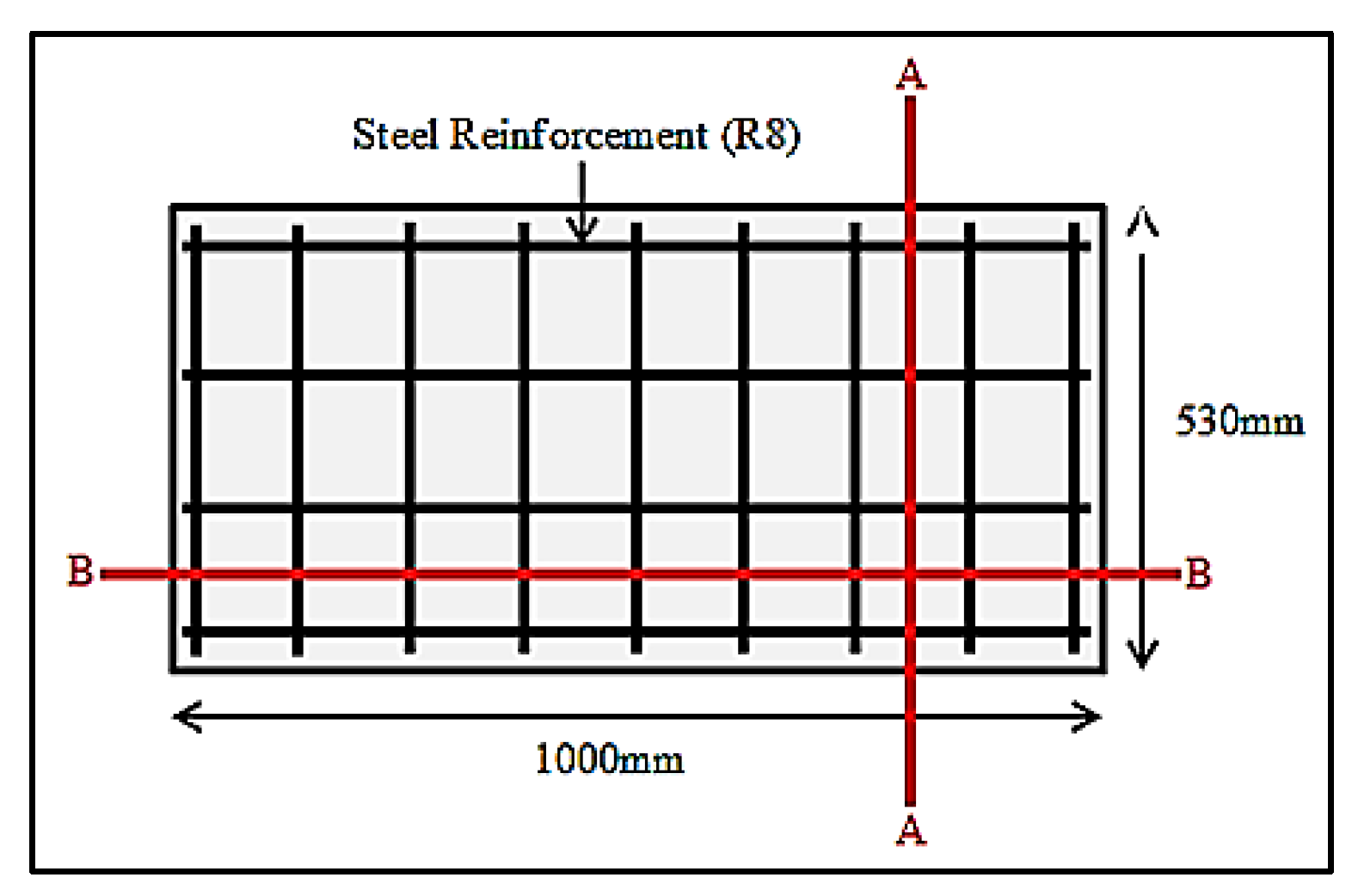
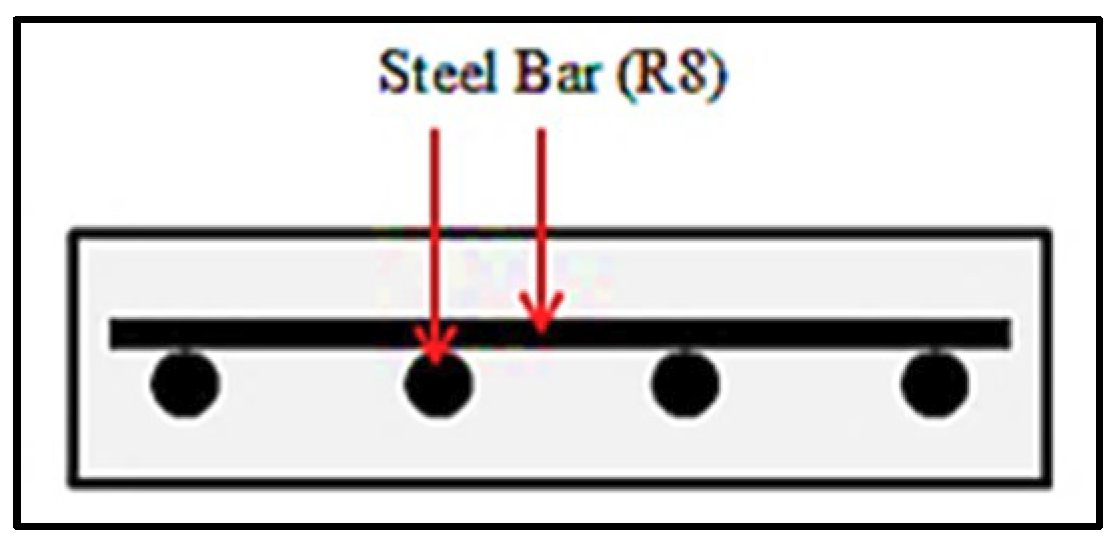


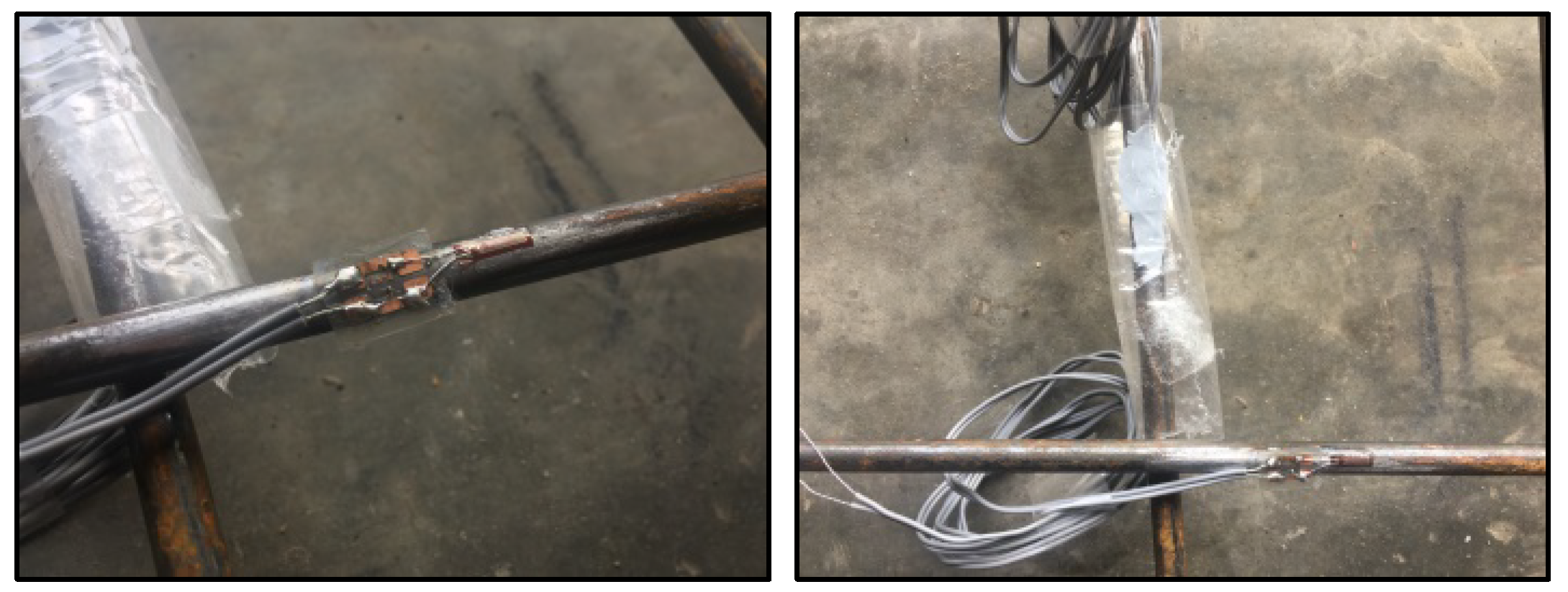
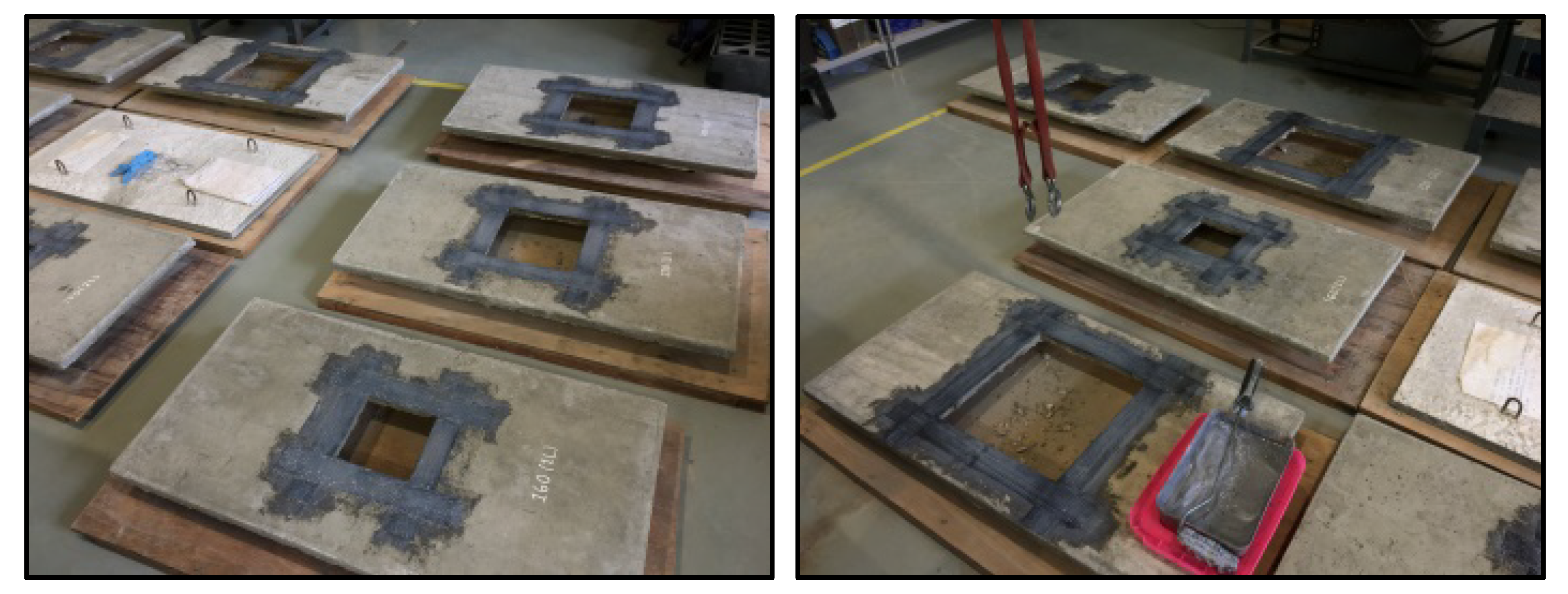

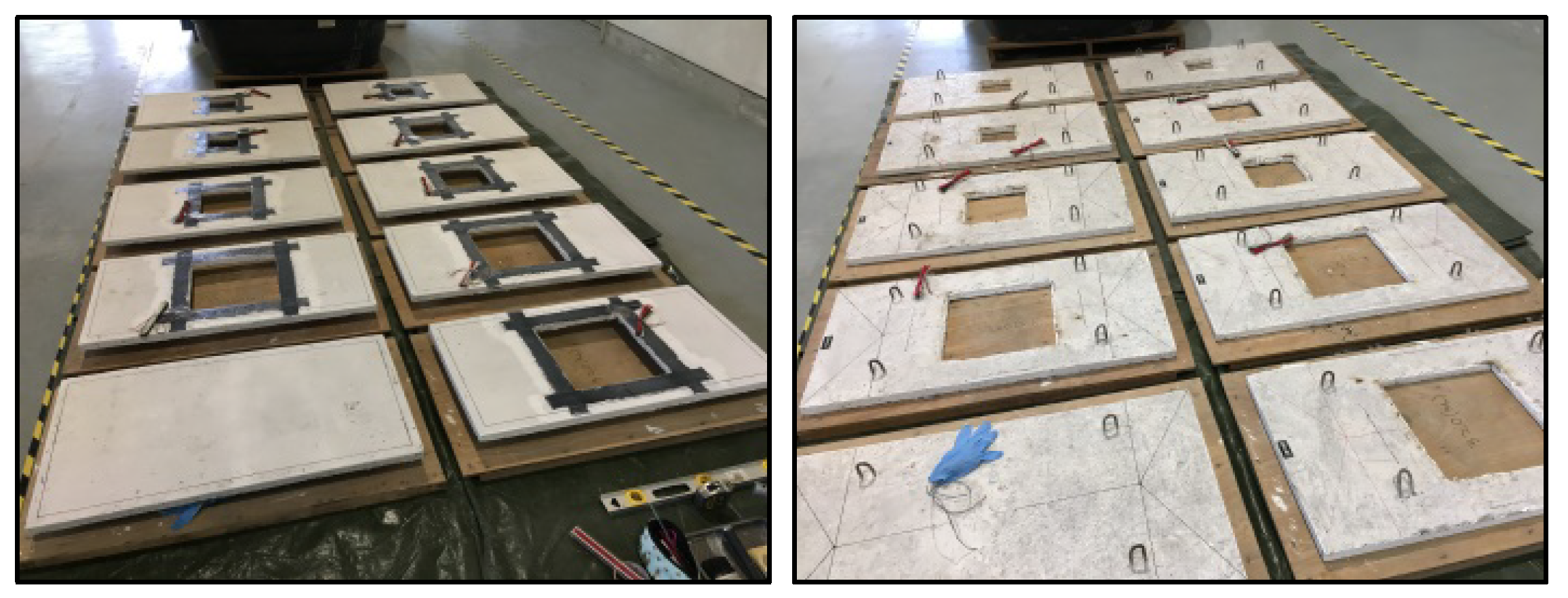
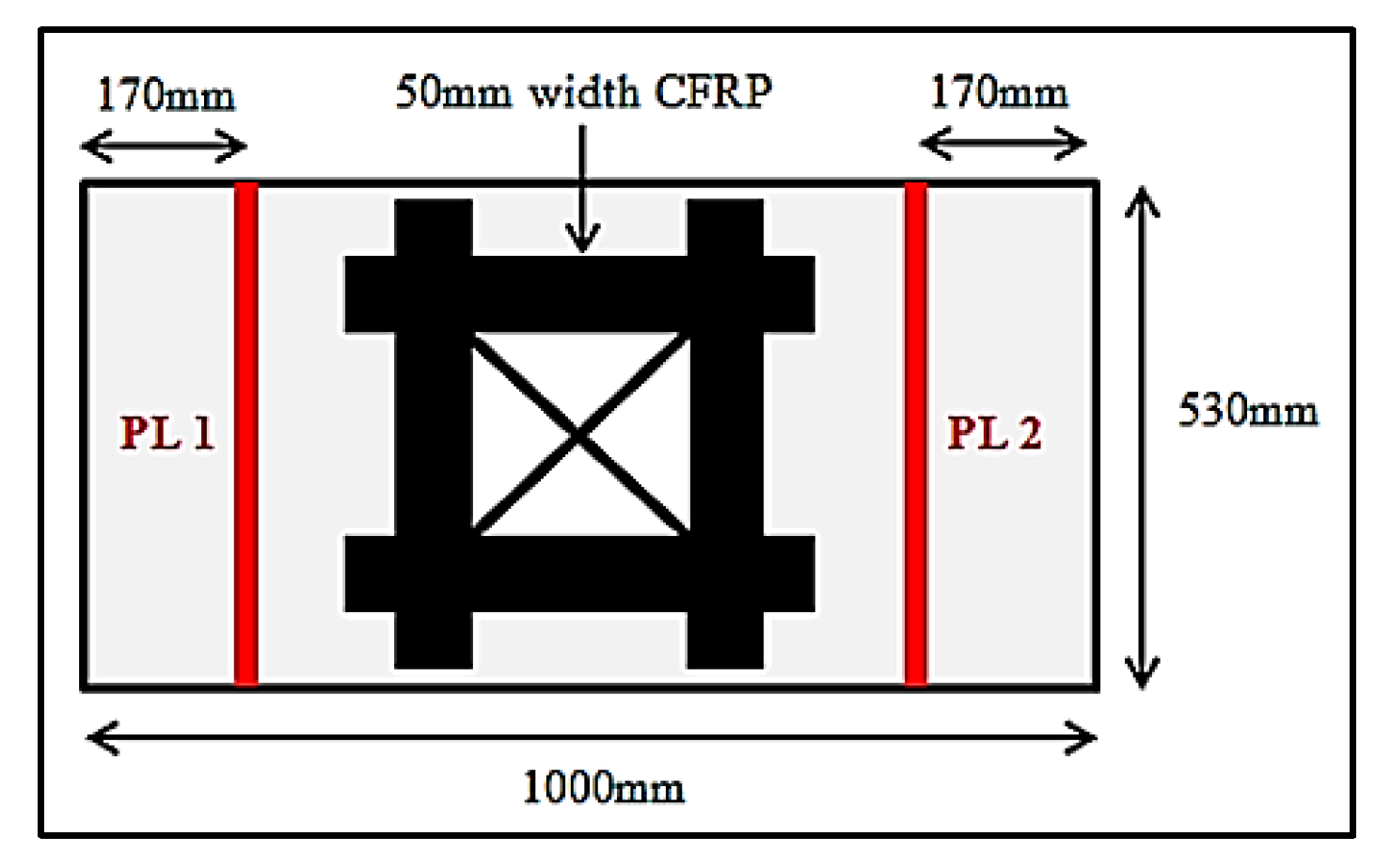
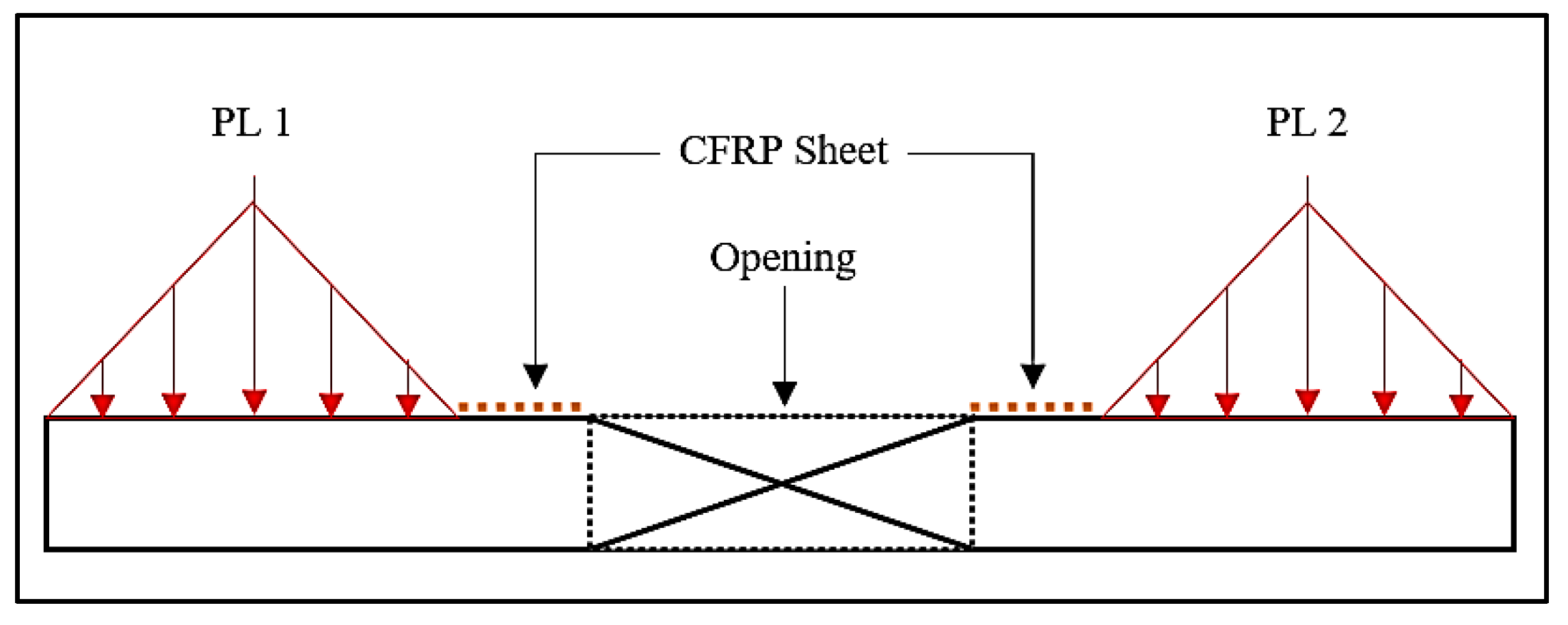
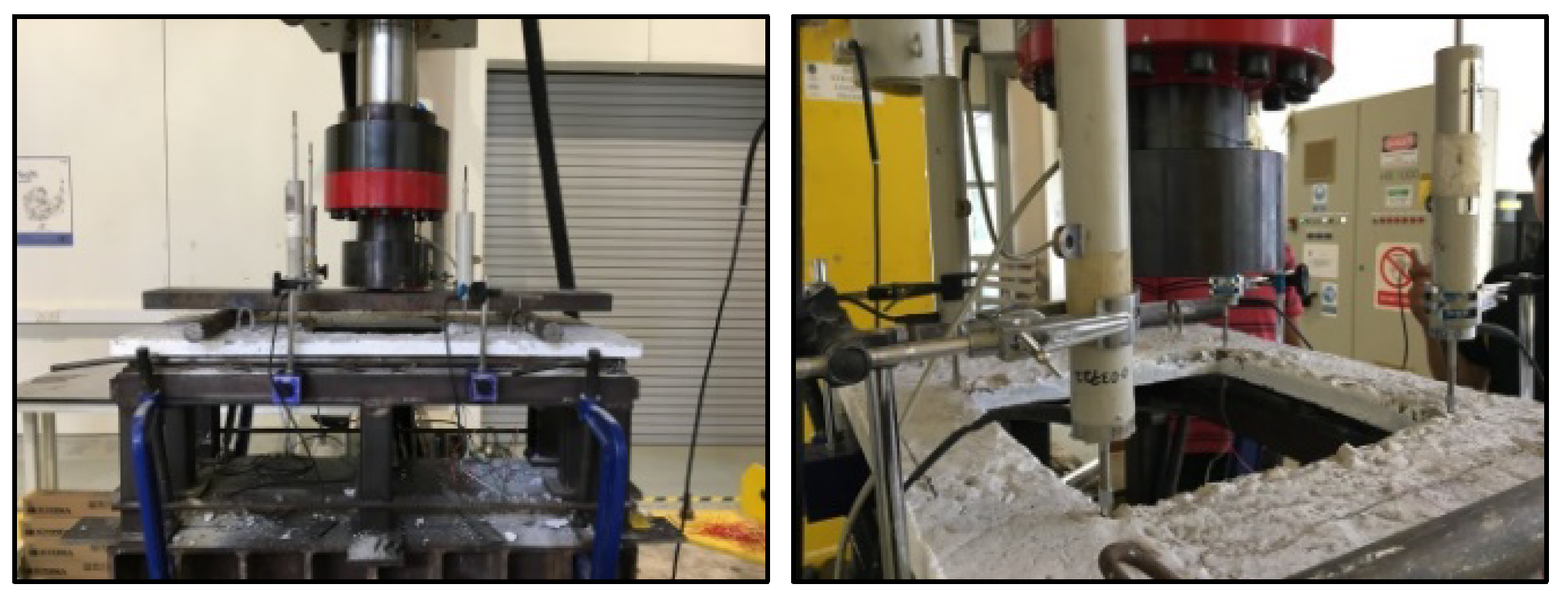

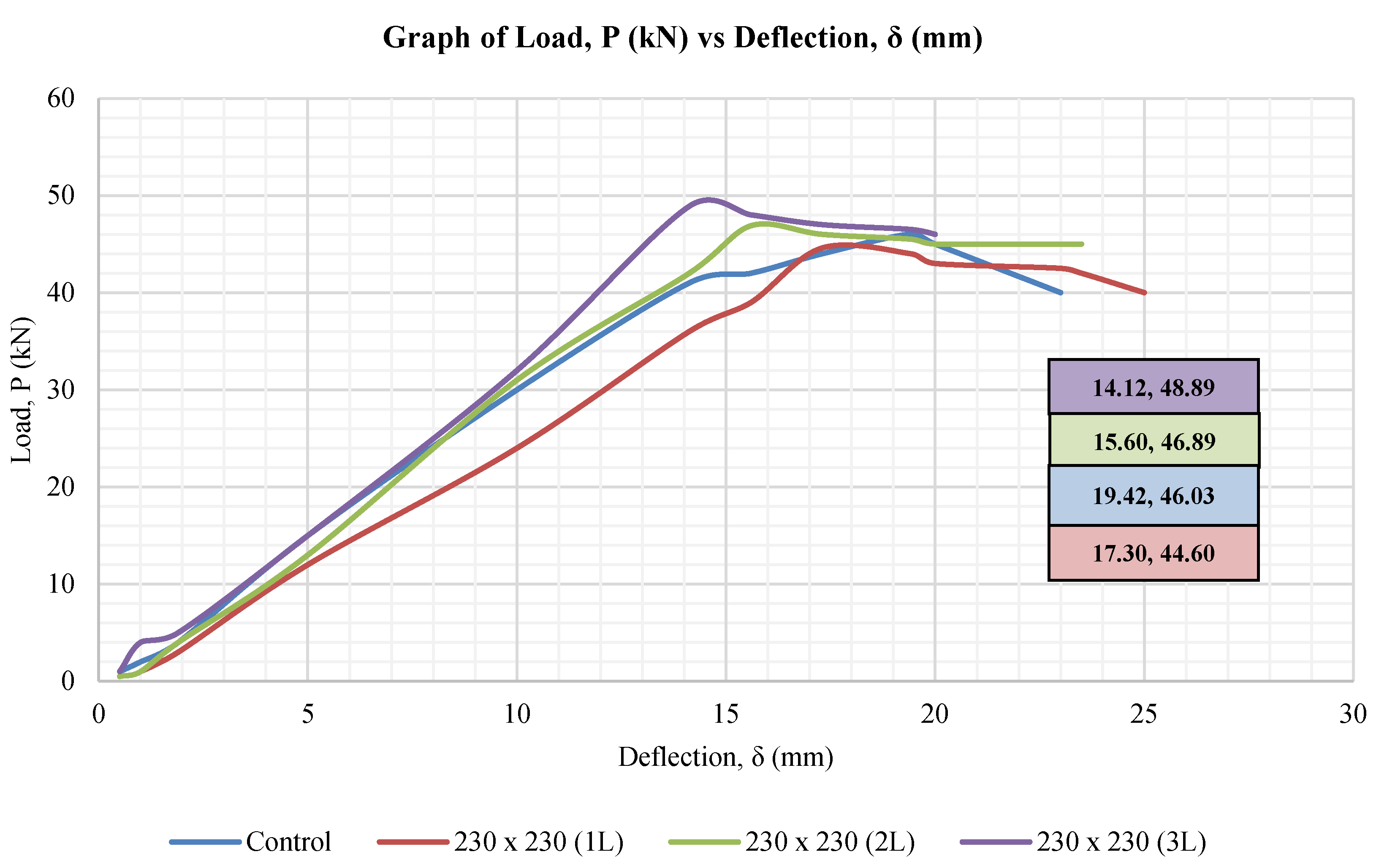
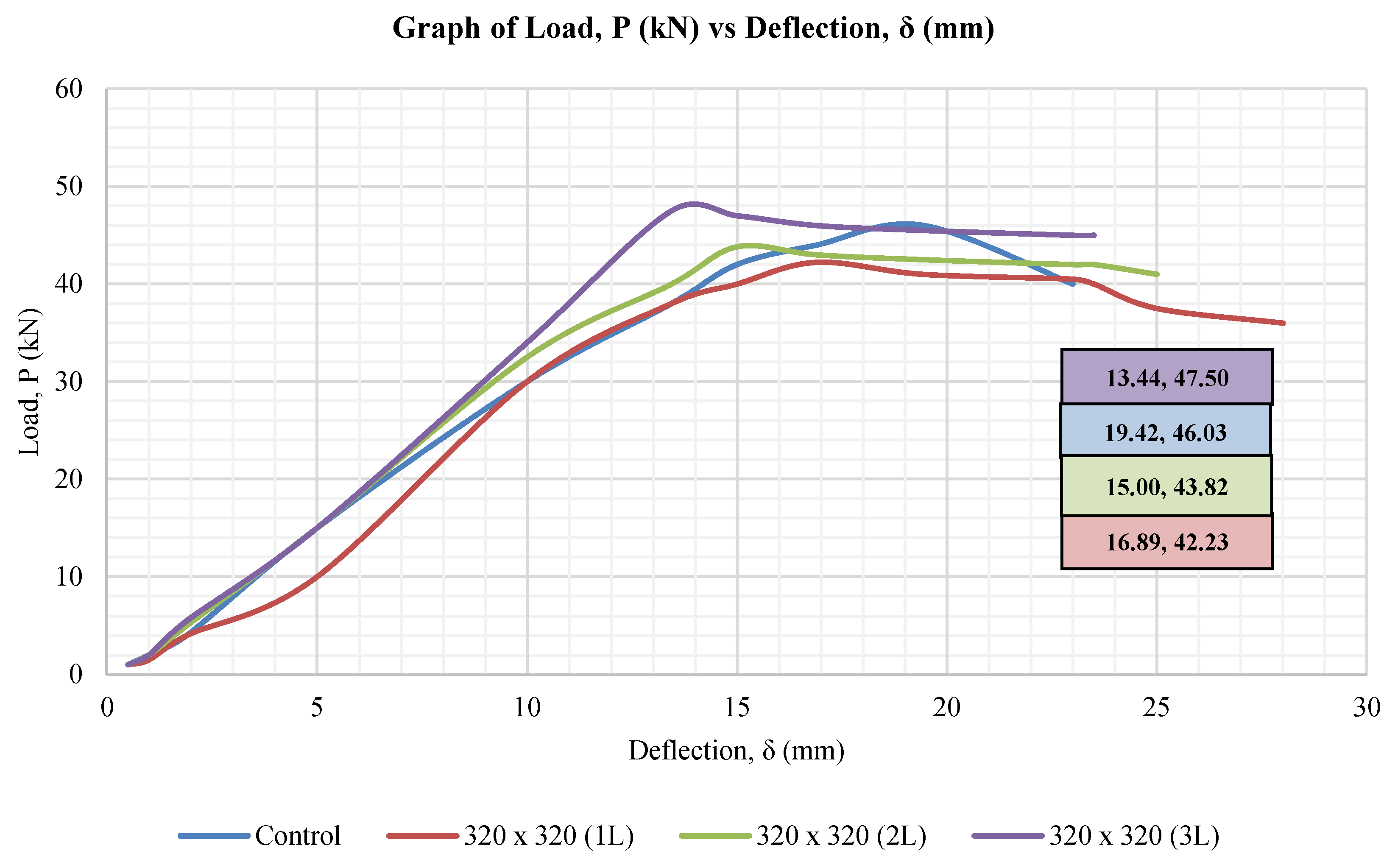

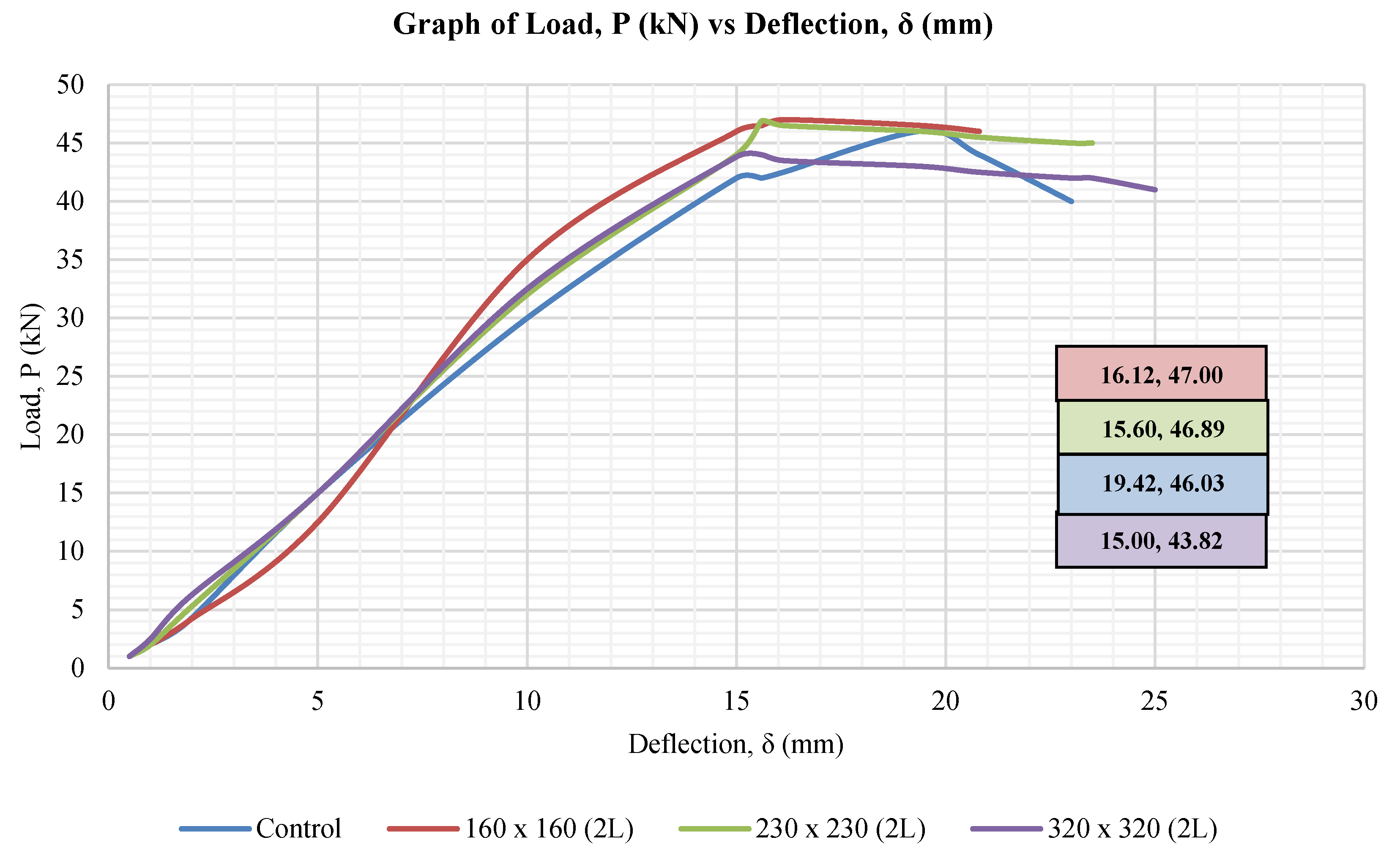
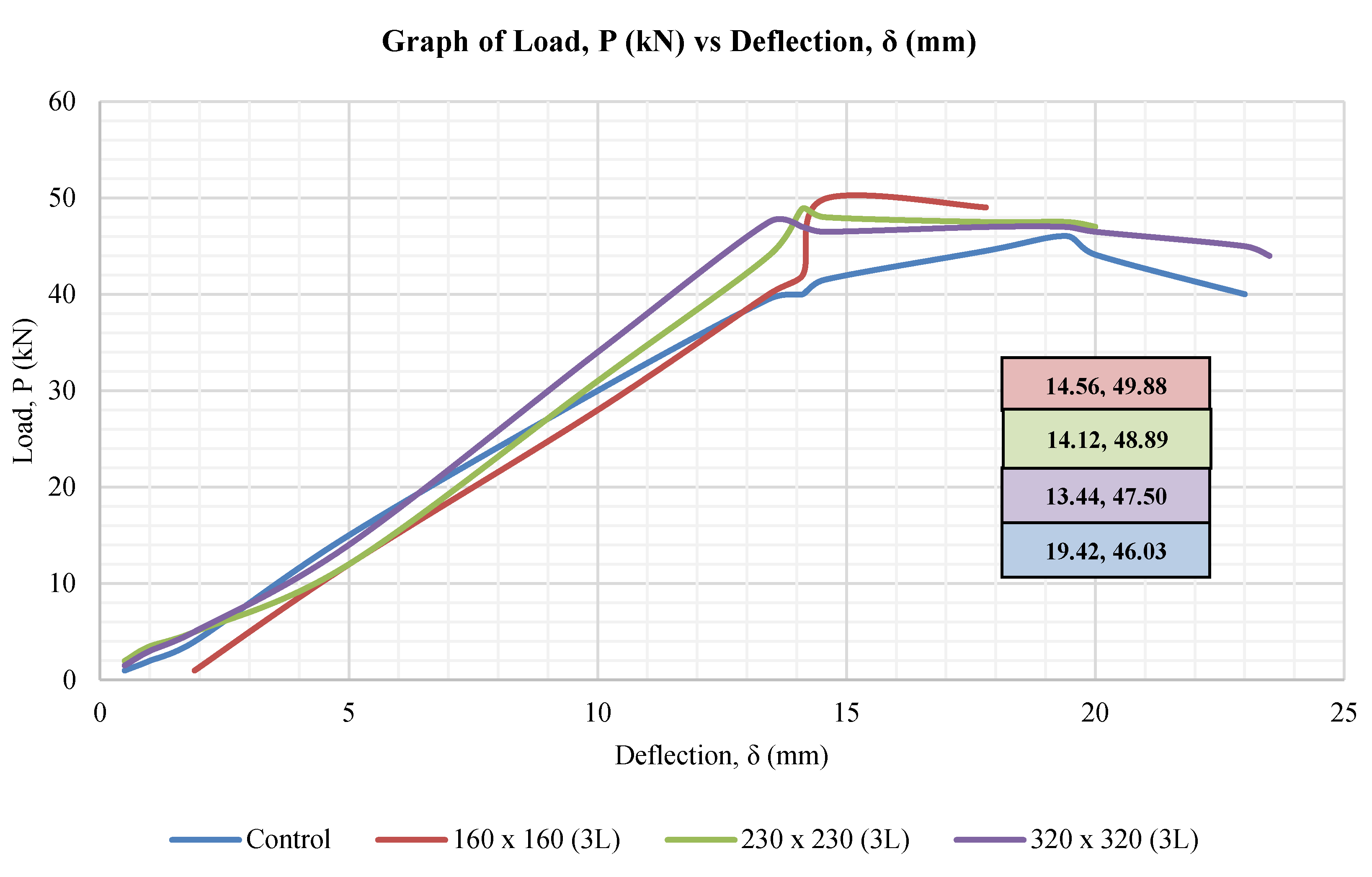
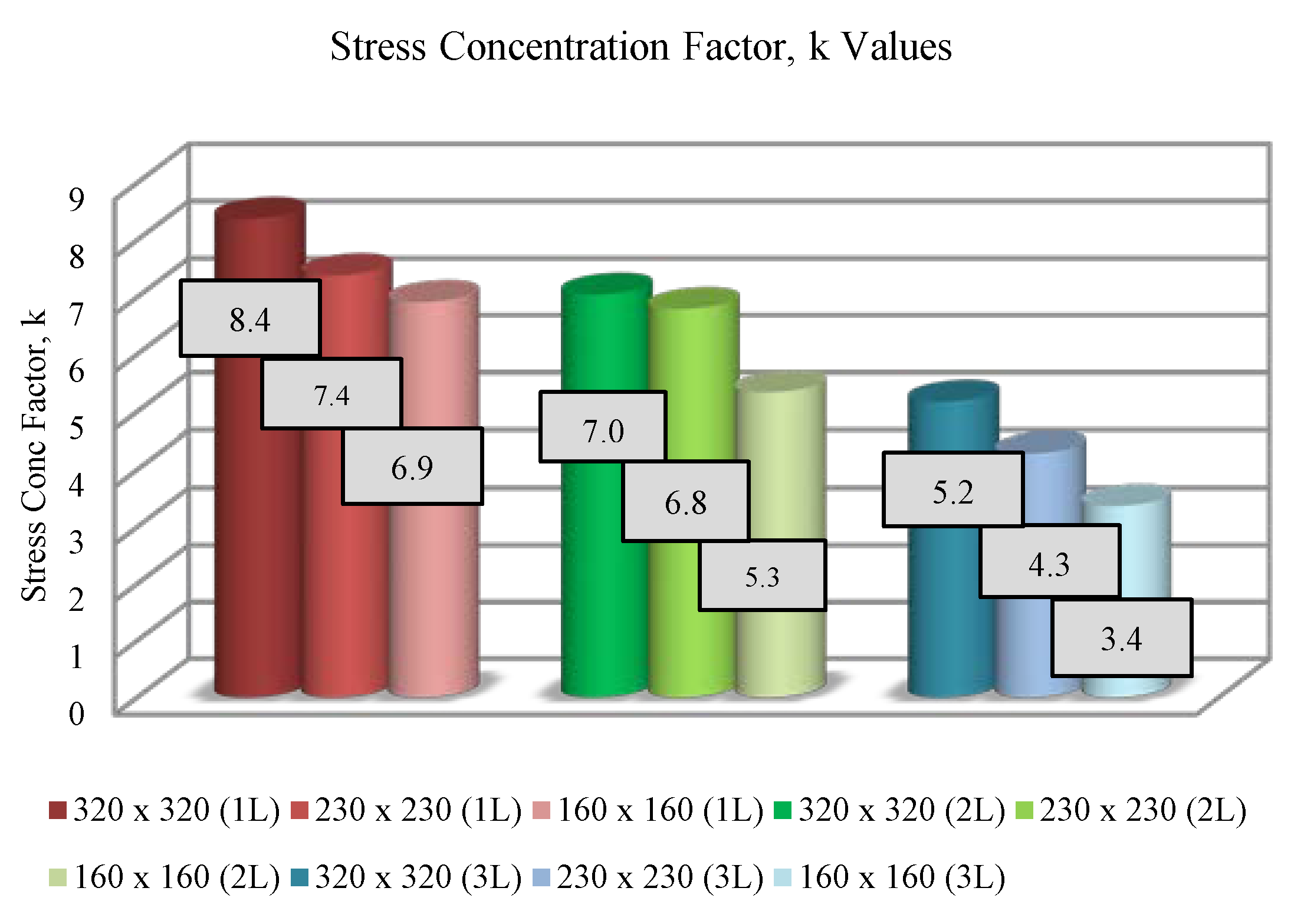
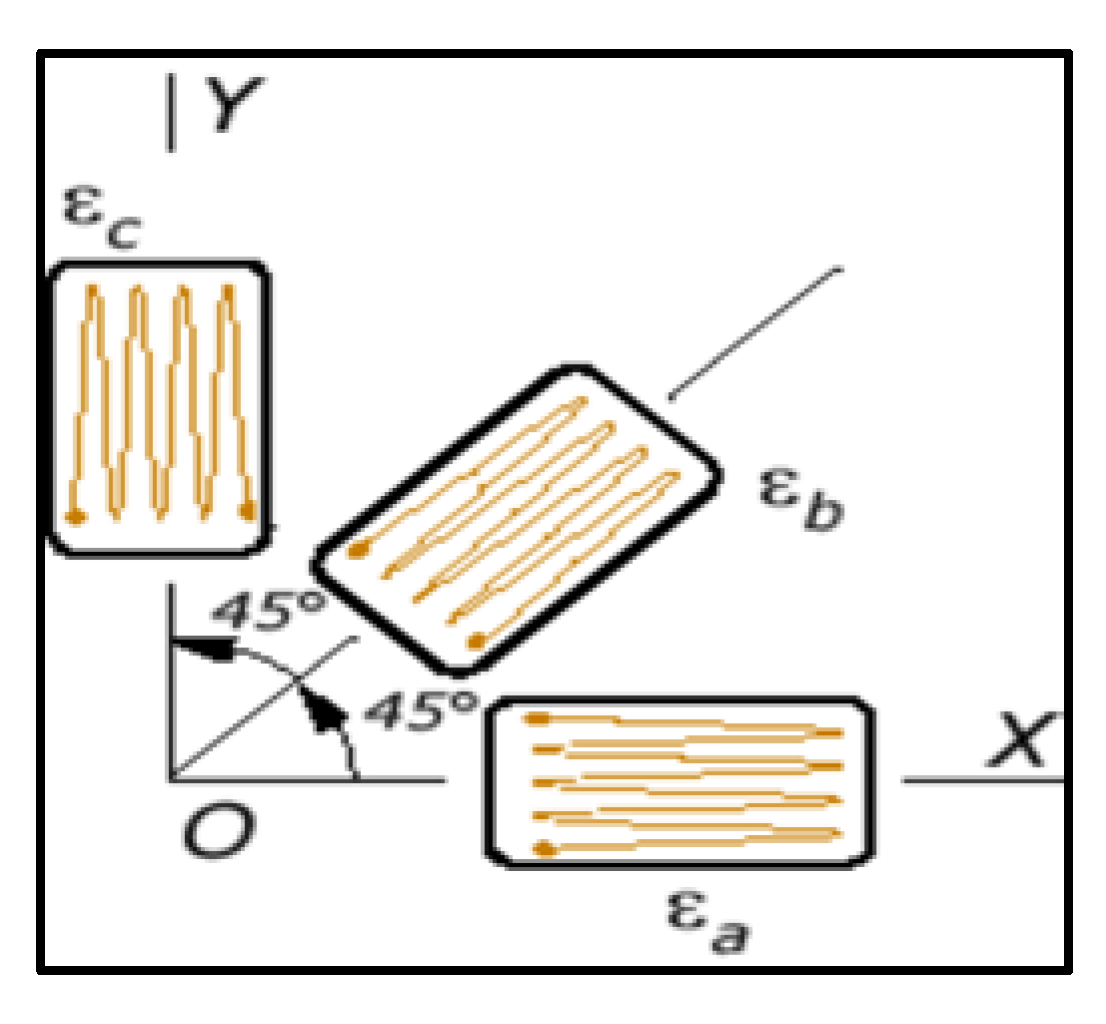
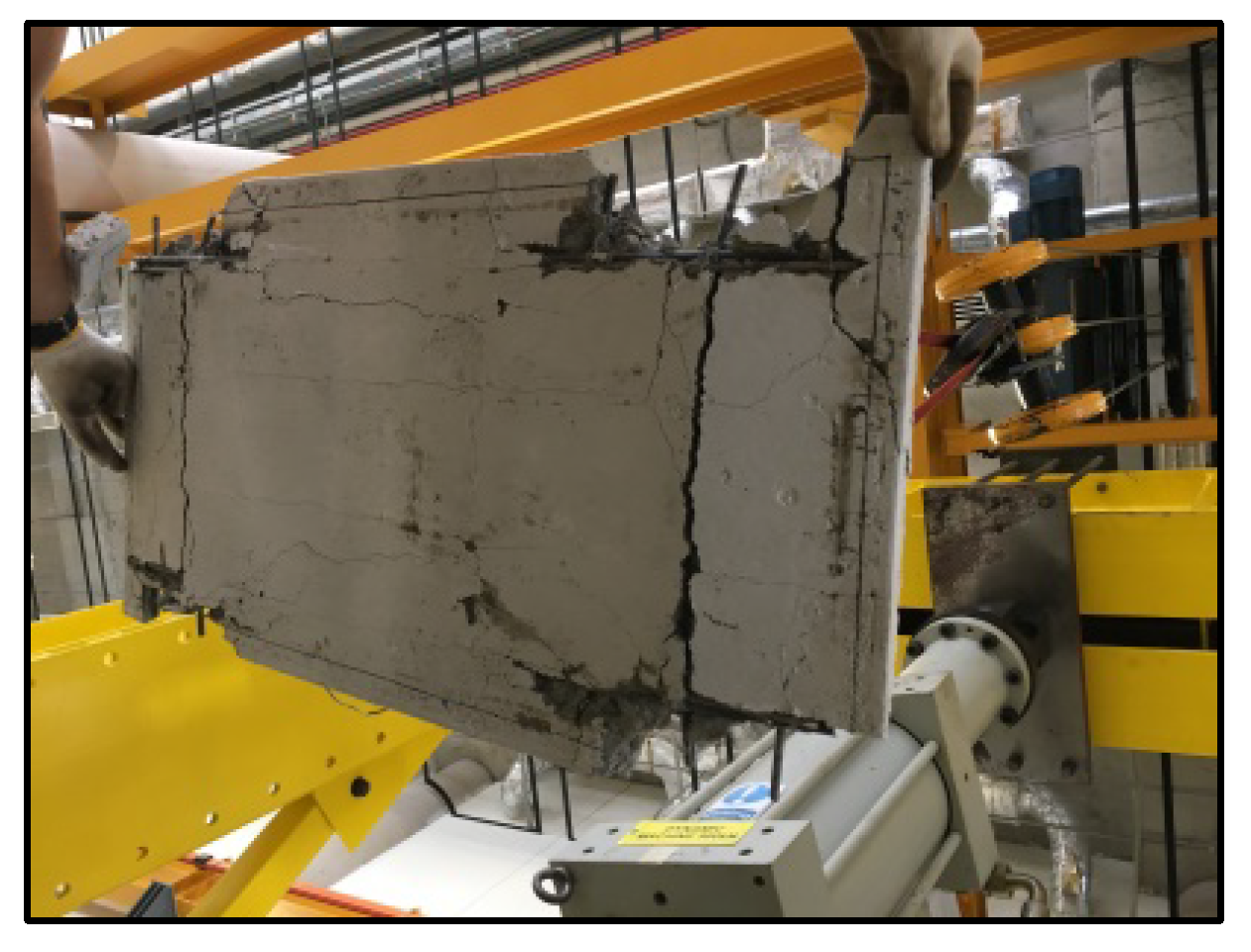

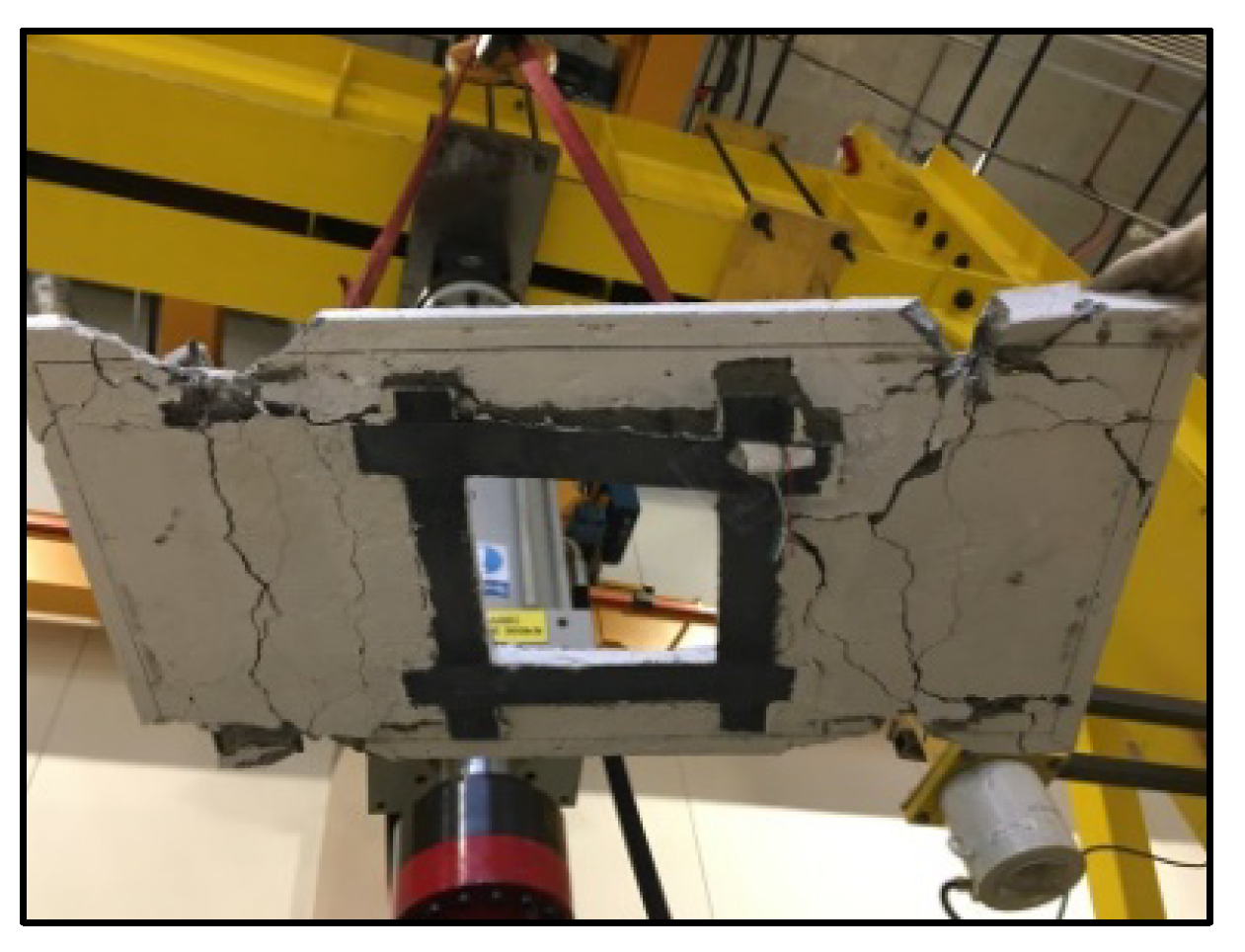
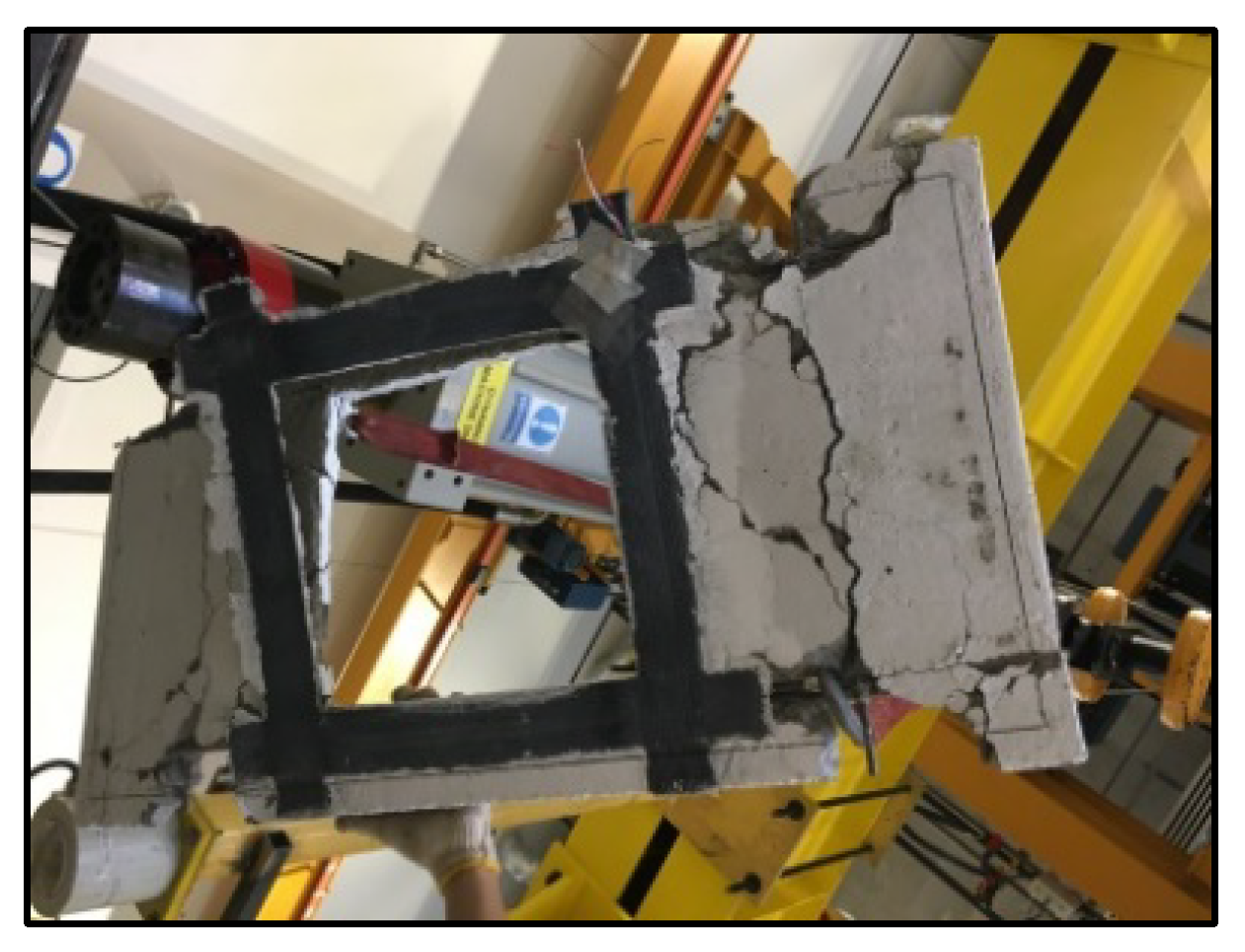
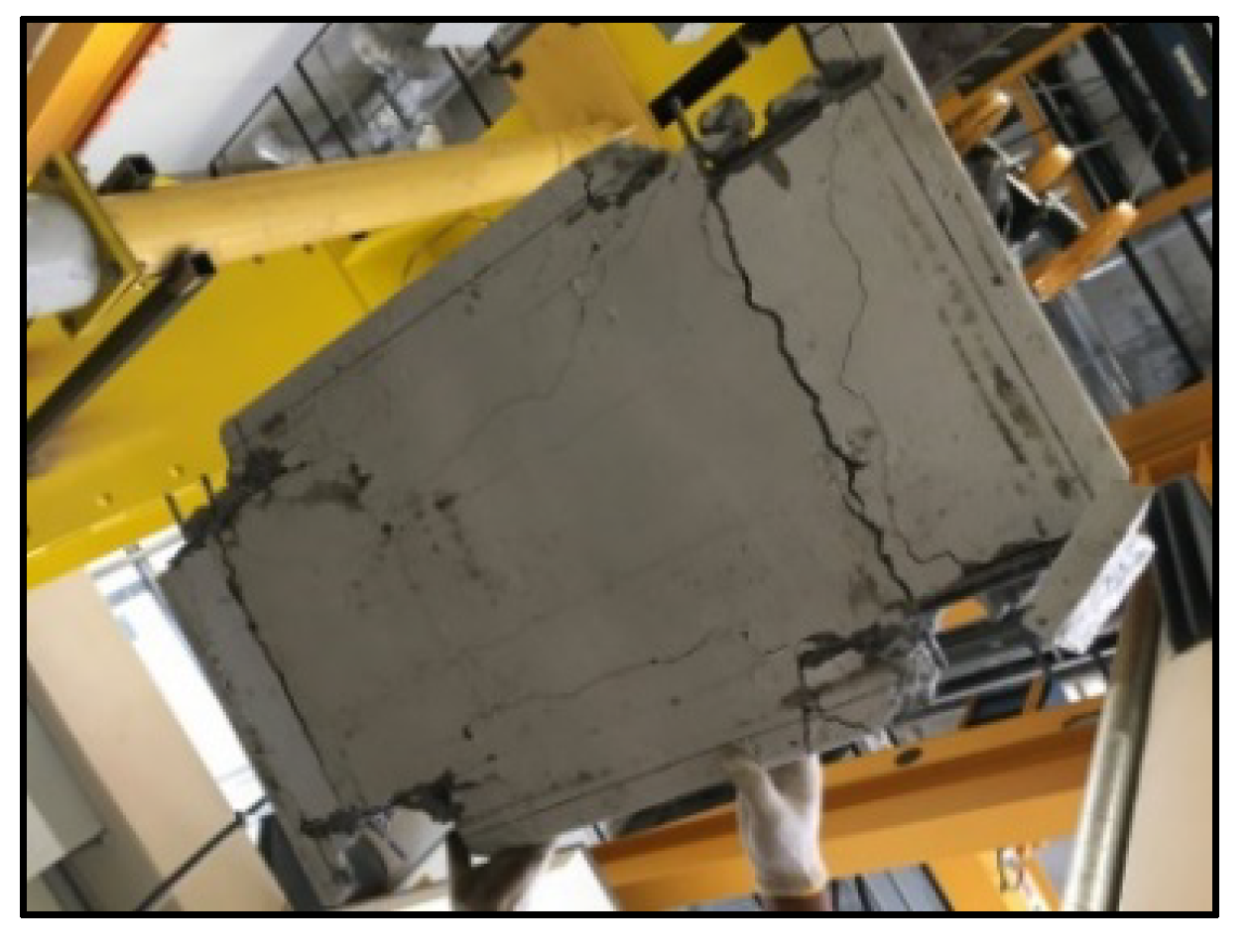
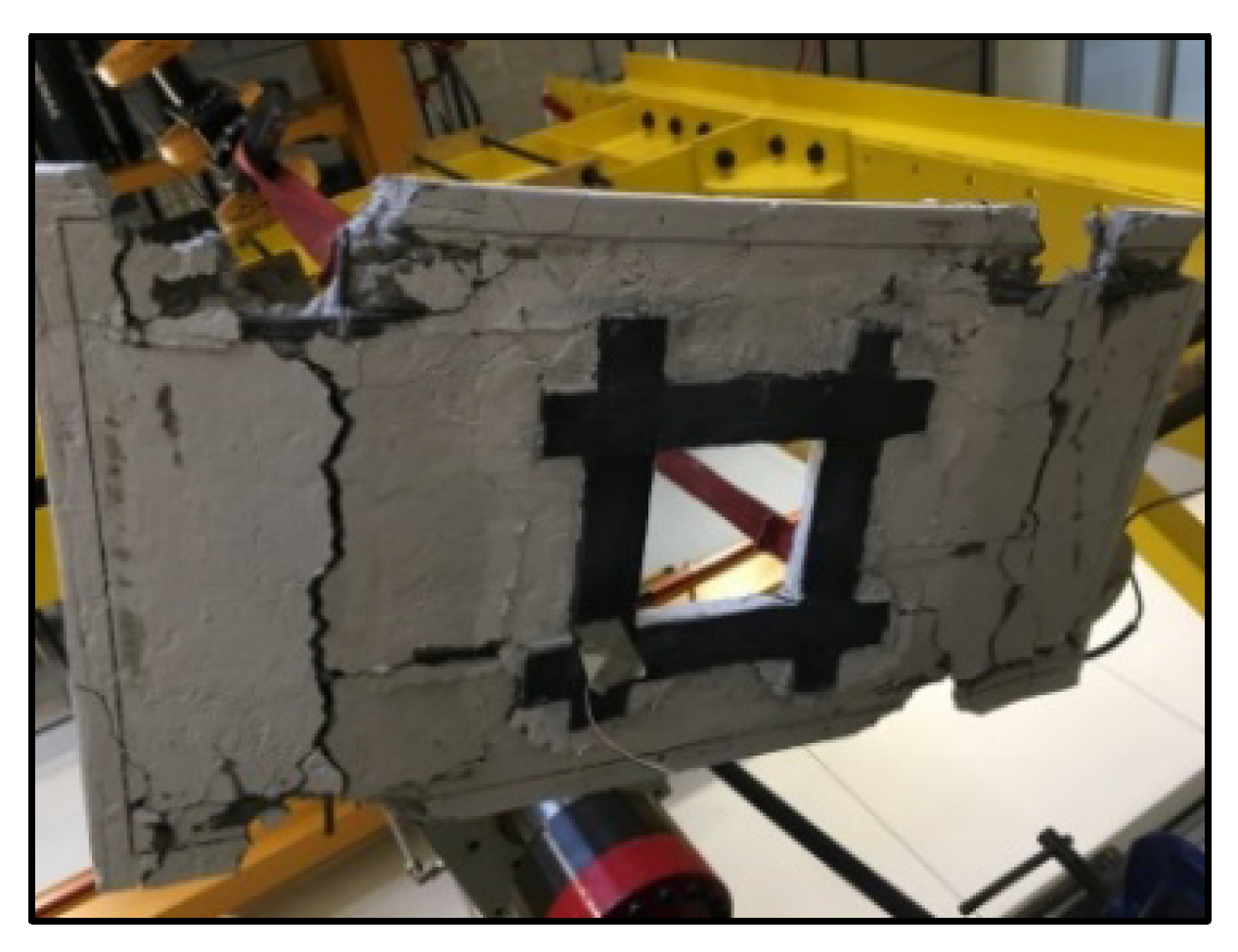
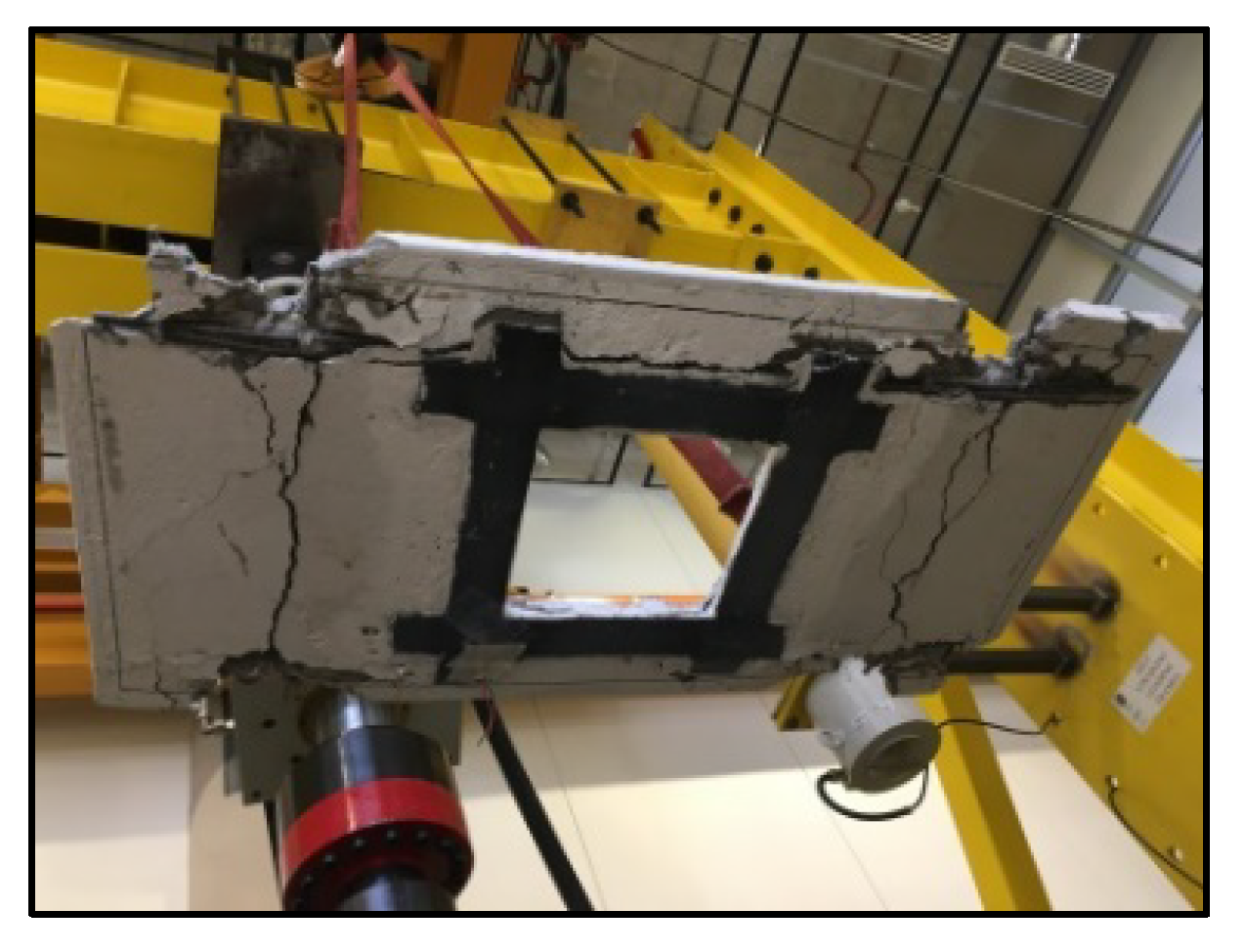
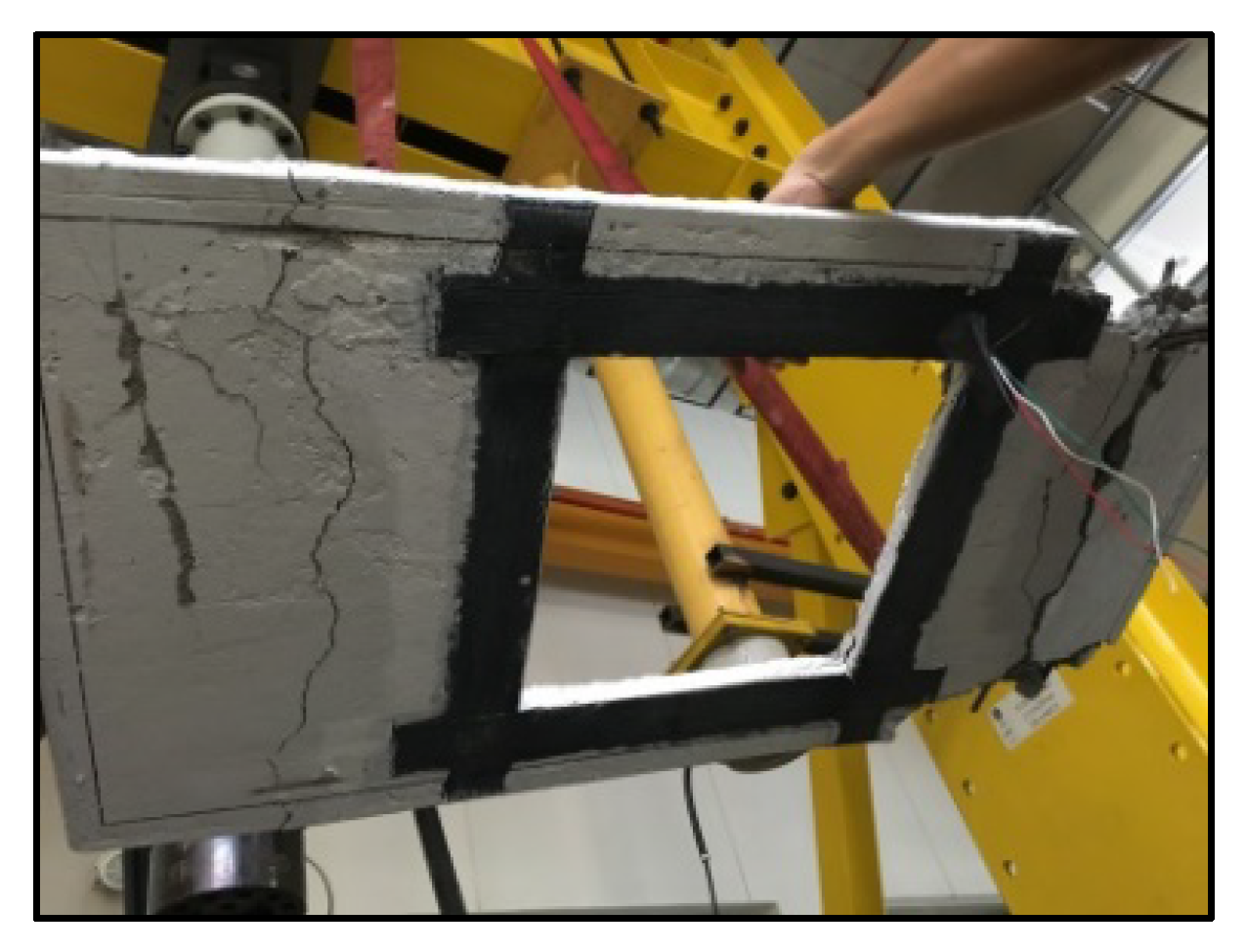

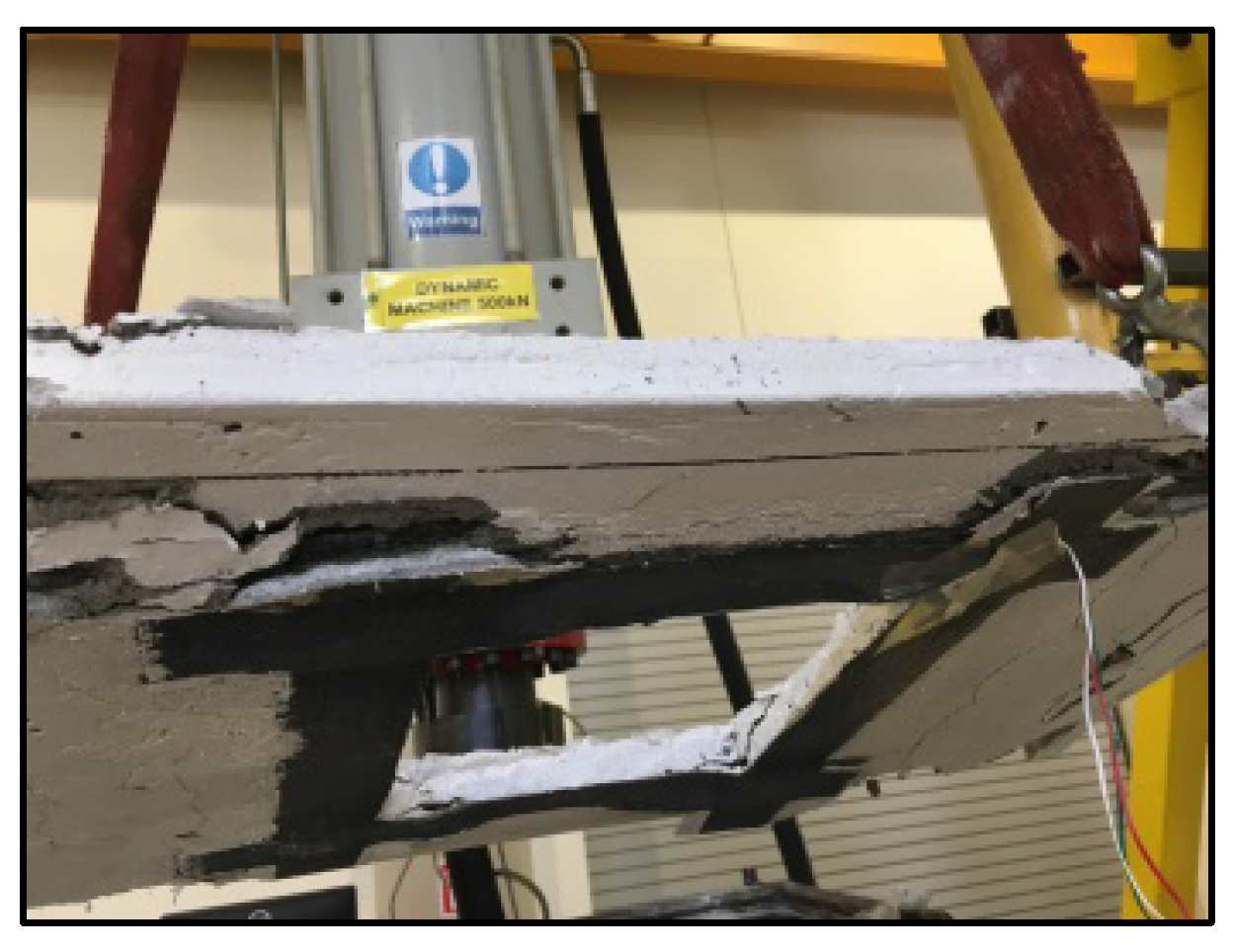

| Grade | Mix Ratio | Min Compressive Strength at Day 7 (MPa) | Max Compressive Strength at Day 28 (MPa) | ||
|---|---|---|---|---|---|
| Cement | Sand | Aggregate | |||
| 25 | 1 | 1 | 2 | 17 | 25 |
| Type | Grade | Diameter (mm) | Ultimate Tensile Stress (MPa) | Yield Stress (MPa) |
|---|---|---|---|---|
| Mild Steel | II | 8 | 370 | 225 |
| Material | Tensile Strength (MPa) | Ultimate Strain (MPa) | Elastic Modulus (MPa) |
|---|---|---|---|
| CFRP Sheet | 4300 | 0.0180 | 23,800 |
| Control | 160 mm × 160 mm | 230 mm × 230 mm | 320 mm × 320 mm |
|---|---|---|---|
| 1 | 0.95 | 0.90 | 0.80 |
| Slab | Load, P (kN) | Flexural Strength, f (MPa) | Deflection, δ (mm) |
|---|---|---|---|
| Control | 46.03 | 8.86 | 19.42 |
| 160 × 160 (1 L) | 45.00 | 8.49 | 18.00 |
| 160 × 160 (2 L) | 47.00 | 9.01 | 15.90 |
| 160 × 160 (3 L) | 49.88 | 9.33 | 15.50 |
| 230 × 230 (1 L) | 44.60 | 8.45 | 18.03 |
| 230 × 230 (2 L) | 46.89 | 8.47 | 16.01 |
| 230 × 230 (3 L) | 48.89 | 9.16 | 15.00 |
| 320 × 320 (1 L) | 42.23 | 7.71 | 19.00 |
| 320 × 320 (2 L) | 43.82 | 8.28 | 17.00 |
| 320 × 320 (3 L) | 47.50 | 9.24 | 16.40 |
© 2020 by the authors. Licensee MDPI, Basel, Switzerland. This article is an open access article distributed under the terms and conditions of the Creative Commons Attribution (CC BY) license (http://creativecommons.org/licenses/by/4.0/).
Share and Cite
Aman, S.S.; S. Mohammed, B.; Wahab, M.A.; Anwar, A. Performance of Reinforced Concrete Slab with Opening Strengthened Using CFRP. Fibers 2020, 8, 25. https://doi.org/10.3390/fib8040025
Aman SS, S. Mohammed B, Wahab MA, Anwar A. Performance of Reinforced Concrete Slab with Opening Strengthened Using CFRP. Fibers. 2020; 8(4):25. https://doi.org/10.3390/fib8040025
Chicago/Turabian StyleAman, Syafiqah Shahrul, Bashar S. Mohammed, Mubarak Abdul Wahab, and Abdullah Anwar. 2020. "Performance of Reinforced Concrete Slab with Opening Strengthened Using CFRP" Fibers 8, no. 4: 25. https://doi.org/10.3390/fib8040025
APA StyleAman, S. S., S. Mohammed, B., Wahab, M. A., & Anwar, A. (2020). Performance of Reinforced Concrete Slab with Opening Strengthened Using CFRP. Fibers, 8(4), 25. https://doi.org/10.3390/fib8040025







